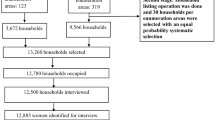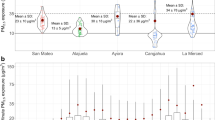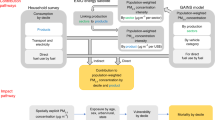Abstract
Background
Clean cooking interventions to reduce air pollution exposure from burning biomass for daily cooking and heating needs have the potential to reduce a large burden of disease globally.
Objective
The objective of this study is to evaluate the air pollution exposure impacts of a fan-assisted efficient biomass-burning cookstove and a liquefied petroleum gas (LPG) stove intervention in rural Ghana.
Methods
We randomized 1414 households in rural Ghana with pregnant mothers into a control arm (N = 526) or one of two clean cooking intervention arms: a fan-assisted efficient biomass-burning cookstove (N = 527) or an LPG stove and cylinder refills as needed (N = 361). We monitored personal maternal carbon monoxide (CO) at baseline and six times after intervention and fine particulate matter (PM2.5) exposure twice after intervention. Children received three CO exposure monitoring sessions.
Results
We obtained 5655 48-h maternal CO exposure estimates and 1903 for children, as well as 1379 maternal PM2.5 exposure estimates. Median baseline CO exposures in the control, improved biomass, and LPG arms were 1.17, 1.17, and 1.30 ppm, respectively. Based on a differences-in-differences approach, the LPG arm showed a 47% reduction (95% confidence interval: 34–57%) in mean 48-h CO exposure compared to the control arm. Mean maternal PM2.5 exposure in the LPG arm was 32% lower than the control arm during the post-intervention period (52 ± 29 vs. 77 ± 44 μg/m3). The biomass stove did not meaningfully reduce CO or PM2.5 exposure.
Conclusions
We show that LPG interventions lowered air pollution exposure significantly compared to three-stone fires. However, post-intervention exposures still exceeded health-relevant targets.
Significance
In a large controlled trial of cleaner cooking interventions, an LPG stove and fuel intervention reduced air pollution exposure in a vulnerable population in a low-resource setting.
This is a preview of subscription content, access via your institution
Access options
Subscribe to this journal
Receive 6 print issues and online access
$259.00 per year
only $43.17 per issue
Buy this article
- Purchase on Springer Link
- Instant access to full article PDF
Prices may be subject to local taxes which are calculated during checkout



Similar content being viewed by others
References
Stanaway JD, Afshin A, Gakidou E, Lim SS, Abate D, Abate KH, et al. Global, regional, and national comparative risk assessment of 84 behavioural, environmental and occupational, and metabolic risks or clusters of risks for 195 countries and territories, 1990–2017: a systematic analysis for the Global Burden of Disease Study 2017. Lancet. 2018;392:1923–94.
Bonjour S, Adair-Rohani H, Wolf J, Bruce NG, Mehta S, Prüss-Ustün A, et al. Solid fuel use for household cooking: country and regional estimates for 1980–2010. Environ Health Perspect. 2013;121:784–90.
Gordon SB, Bruce NG, Grigg J, Hibberd PL, Kurmi OP, Lam KH, et al. Respiratory risks from household air pollution in low and middle income countries. Lancet Respir Med. 2014;2:823–60.
Lee A, Kinney P, Chillrud S, Jack D. A systematic review of innate immunomodulatory effects of household air pollution secondary to the burning of biomass fuels. Ann Glob Health. 2015;81:368–374.
Amegah AK, Quansah R, Jaakkola JJK. Household air pollution from solid fuel use and risk of adverse pregnancy outcomes: a systematic review and meta-analysis of the empirical evidence. PLoS ONE. 2014;9:e113920.
Fatmi Z, Coggon D. Coronary heart disease and household air pollution from use of solid fuel: a systematic review. Br Med Bull. 2016;118:91–109.
Sood A, Assad NA, Barnes PJ, Churg A, Gordon SB, Harrod KS, et al. ERS/ATS workshop report on respiratory health effects of household air pollution. Eur Respir J. 2018;51. https://doi.org/10.1183/13993003.00698-2017.
Onakomaiya D, Gyamfi J, Iwelunmor J, Opeyemi J, Oluwasanmi M, Obiezu-Umeh C, et al. Implementation of clean cookstove interventions and its effects on blood pressure in low-income and middle-income countries: systematic review. BMJ Open. 2019;9:e026517.
Simkovich SM, Goodman D, Roa C, Crocker ME, Gianella GE, Kirenga BJ, et al. The health and social implications of household air pollution and respiratory diseases. npj Prim Care Respir Med. 2019;29:12.
Smith KR, McCracken JP, Weber MW, Hubbard A, Jenny A, Thompson LM, et al. Effect of reduction in household air pollution on childhood pneumonia in Guatemala (RESPIRE): a randomised controlled trial. Lancet. 2011;378:1717–26.
Alexander DA, Northcross A, Karrison T, Morhasson-Bello O, Wilson N, Atalabi OM, et al. Pregnancy outcomes and ethanol cook stove intervention: a randomized-controlled trial in Ibadan, Nigeria. Environ Int. 2018;111:152–163.
McCracken JP, Smith KR, Díaz A, Mittleman MA, Schwartz J. Chimney stove intervention to reduce long-term wood smoke exposure lowers blood pressure among Guatemalan women. Environ Health Perspect. 2007;115:996–1001.
Alexander D, Northcross A, Wilson N, Dutta A, Pandya R, Ibigbami T, et al. Randomized controlled ethanol cookstove intervention and blood pressure in pregnant Nigerian women. Am J Respir Crit Care Med. 2017;195:1629–39.
Lee AG, Kaali S, Quinn A, Delimini R, Burkart K, Opoku-Mensah J, et al. Prenatal household air pollution is associated with impaired infant lung function with sex-specific effects: evidence from GRAPHS, a cluster randomized cookstove intervention trial. Am J Respir Crit Care Med. 2018. https://doi.org/10.1164/rccm.201804-0694OC.
Thompson LM, Bruce N, Eskenazi B, Diaz A, Pope D, Smith KR. Impact of reduced maternal exposures to wood smoke from an introduced chimney stove on newborn birth weight in rural Guatemala. Environ Health Perspect. 2011;119:1489–94.
Katz J, Tielsch JM, Khatry SK, Shrestha L, Breysse P, Zeger SL, et al. Impact of improved biomass and liquid petroleum gas stoves on birth outcomes in rural Nepal: results of 2 randomized trials. Glob Health Sci Pract. 2020;8:GHSP-D-20-00011v2.
Smith KR, Mccracken JP, Thompson L, Edwards R, Shields KN, Canuz E, et al. Personal child and mother carbon monoxide exposures and kitchen levels: methods and results from a randomized trial of woodfired chimney cookstoves in Guatemala (RESPIRE). J Expo Sci Environ Epidemiol. 2010;20:406–16.
Pope D, Bruce N, Dherani M, Jagoe K, Rehfuess E. Real-life effectiveness of ‘improved’ stoves and clean fuels in reducing PM2.5 and CO: systematic review and meta-analysis. Environ Int. 2017;101:7–18.
Rosa G, Majorin F, Boisson S, Barstow C, Johnson M, Kirby M, et al. Assessing the impact of water filters and improved cook stoves on drinking water quality and household air pollution: a randomised controlled trial in Rwanda. PLoS ONE. 2014;9:e91011.
Cohen AJ, Brauer M, Burnett R, Anderson HR, Frostad J, Estep K, et al. Estimates and 25-year trends of the global burden of disease attributable to ambient air pollution: an analysis of data from the Global Burden of Diseases Study 2015. Lancet. 2017;389:1907–18.
Clark ML, Peel JL, Balakrishnan K, Breysse PN, Chillrud SN, Naeher LP, et al. Health and household air pollution from solid fuel use: the need for improved exposure assessment. Environ Health Perspect. 2013;121:1120–8.
Jack DW, Asante KP, Wylie BJ, Chillrud SN, Whyatt RM, Ae-Ngibise KA, et al. Ghana Randomized Air Pollution and Health Study (GRAPHS): study protocol for a randomized controlled trial. Trials. 2015;16:420.
Mortimer K, Ndamala CB, Naunje AW, Malava J, Katundu C, Weston W, et al. A cleaner burning biomass-fuelled cookstove intervention to prevent pneumonia in children under 5 years old in rural Malawi (the Cooking and Pneumonia Study): a cluster randomised controlled trial. Lancet. 2017;389:167–75.
NIH Project Reporter. Household Air Pollution Intervention Network (HAPIN), trial registration NCT0294468. NIH Project Reporter. 2018. https://projectreporter.nih.gov/project_info_description.cfm?aid=9207315&icde=31240699&ddparam=&ddvalue=&ddsub=&cr=1&csb=default&cs=ASC. Accessed 6 Jun 2018.
Fandiño-Del-Rio M, Goodman D, Kephart JL, Miele CH, Williams KN, Moazzami M, et al. Effects of a liquefied petroleum gas stove intervention on pollutant exposure and adult cardiopulmonary outcomes (CHAP): study protocol for a randomized controlled trial. Trials. 2017;18:518.
Tielsch JM, Katz J, Zeger SL, Khatry SK, Shrestha L, Breysse P, et al. Designs of two randomized, community-based trials to assess the impact of alternative cookstove installation on respiratory illness among young children and reproductive outcomes in rural Nepal. BMC Public Health. 2014;14:1271.
Raynes-Greenow C. The poriborton/change trial: Household Air Pollution and Perinatal and early Neonatal mortality, trial registration U1111-1190-1483. Australian New Zealand Clinical Trial Registry. 2018. https://www.anzctr.org.au/Trial/Registration/TrialReview.aspx?id=371896. Accessed 11 Sep 2019.
Clean Cooking Alliance. BioLite HomeStove. Clean Cooking Catalog. http://catalog.cleancookstoves.org/stoves/64. Accessed 30 Sep 2020.
Jetter J, Ebersviller S. Test report, BioLite home stove with wood fuel, air pollutant emissions and fuel efficiency. North Carolina: US Environmental Protection Agency: Research Triangle Park. 2015. https://cfpub.epa.gov/si/si_public_record_report.cfm?Lab=NRMRL&dirEntryId=318121. Accessed 30 Sep 2020.
Van Vliet EDS, Asante K, Jack DW, Kinney PL, Whyatt RM, Chillrud SN, et al. Personal exposures to fine particulate matter and black carbon in households cooking with biomass fuels in rural Ghana. Environ Res. 2013;127:40–8.
Government of Ghana. Voluntary National Review Report on the Implementation of the 2030 Agenda for Sustainable Development. Accra: Government of Ghana. 2019 https://sustainabledevelopment.un.org/content/documents/23420Ghanas_VNR_report_Final.pdf. Accessed 30 Mar 2020.
Ofosu FG, Hopke PK, Aboh IJK, Bamford SA. Biomass burning contribution to ambient air particulate levels at Navrongo in the Savannah zone of Ghana. J Air Waste Manag Assoc. 2013;63:1036–45.
McCracken JP, Schwartz J, Diaz A, Bruce N, Smith KR. Longitudinal relationship between personal CO and personal PM2.5 among women cooking with woodfired cookstoves in Guatemala. PLoS ONE. 2013;8. https://doi.org/10.1371/journal.pone.0055670.
McCracken JP, Schwartz J, Bruce N, Mittleman M, Ryan LM, Smith KR. Combining individual- and group-level exposure information: child carbon monoxide in the guatemala woodstove randomized control trial. Epidemiology. 2009;20:127–36.
Northcross A, Chowdhury Z, McCracken J, Canuz E, Smith KR. Estimating personal PM2.5 exposures using CO measurements in Guatemalan households cooking with wood fuel. J Environ Monit. 2010;12:873.
Dionisio KL, Howie S, Fornace KM, Chimah O, Adegbola RA, Ezzati M. Measuring the exposure of infants and children to indoor air pollution from biomass fuels in The Gambia. Indoor Air. 2008;18:317–27.
World Health Organization, editor. WHO guidelines for indoor air quality: household fuel combustion. Geneva: World Health Organization; 2014.
Quansah R, Semple S, Ochieng CA, Juvekar S, Armah FA, Luginaah I, et al. Effectiveness of interventions to reduce household air pollution and/or improve health in homes using solid fuel in low-and-middle income countries: a systematic review and meta-analysis. Environ Int. 2017;103:73–90.
Burnett RT, Pope CA, Ezzati M, Olives C, Lim SS, Mehta S, et al. An integrated risk function for estimating the global burden of disease attributable to ambient fine particulate matter exposure. Environ Health Perspect. 2014;122:397–403.
Carter E, Norris C, Dionisio KL, Balakrishnan K, Checkley W, Clark ML, et al. Assessing exposure to household air pollution: a systematic review and pooled analysis of carbon monoxide as a surrogate measure of particulate matter. Environ Health Perspect. 2017;125:076002.
Quinn AK. Modifiable risk in a changing climate: linking household-level temperature, humidity, and air pollution to population health. 2016. https://academiccommons.columbia.edu/doi/10.7916/D83F4PWW. Accessed 11 Sep 2019.
Quinn AK, Ae-Ngibise KA, Jack DW, Boamah EA, Enuameh Y, Mujtaba MN, et al. Association of carbon monoxide exposure with blood pressure among pregnant women in rural Ghana: evidence from GRAPHS. Int J Hyg Environ Health. 2016;219:176–83.
Liang K-Y, Zeger SL. Longitudinal data analysis using generalized linear models. Biometrika. 1986;73:13–22.
Peters TJ, Richards SH, Bankhead CR, Ades AE, Sterne JAC. Comparison of methods for analysing cluster randomized trials: an example involving a factorial design. Int J Epidemiol. 2003;32:840–6.
Owusu-Agyei S, Ernest A, Nettey O, Zandoh C, Sulemana A, Adda R, et al. Demographic patterns and trends in Central Ghana: baseline indicators from the Kintampo Health and Demographic Surveillance System. Glob Health Action. 2012;5:19033.
R Core Team. R: a language and environment for statistical computing. Vienna: R Foundation for Statistical Computing; 2019 https://www.R-project.org/.
Halekoh U, Højsgaard S, Yan J. The R Package ‘geepack’ for generalized estimating equations. J Stat Softw. 2006;15. https://doi.org/10.18637/jss.v015.i02.
Johnson MA, Steenland K, Piedrahita R, Clark ML, Pillarisetti A, Balakrishnan K, et al. Air pollutant exposure and stove use assessment methods for the Household Air Pollution Intervention Network (HAPIN) trial. Environ Health Perspect. 2020;128:047009.
Johnson M, Piedrahita R, Garland C, Pillarisetti A, Sambandam S, Gurusamy T, et al. Exposures to PM2.5 associated with LPG stove and fuel interventions in four countries: pilot results from the HAPIN Trial. ISEE Conference Abstracts. 2018. https://doi.org/10.1289/isesisee.2018.O02.03.31. Accessed 20 Dec 2018.
Ruiz-Mercado I, Masera O. Patterns of stove use in the context of fuel–device stacking: rationale and implications. EcoHealth. 2015;12:42–56.
Dickinson KL, Piedrahita R, Coffey ER, Kanyomse E, Alirigia R, Molnar T, et al. Adoption of improved biomass stoves and stove/fuel stacking in the REACCTING intervention study in Northern Ghana. Energy Policy. 2019;130:361–74.
Gould CF, Schlesinger SB, Molina E, Bejarano ML, Valarezo A, Jack DW. Household fuel mixes in peri-urban and rural ecuador: explaining the context of LPG, patterns of continued firewood use, and the challenges of induction cooking. Energy Policy. 2020;136:111053.
Puzzolo E, Pope D, Stanistreet D, Rehfuess EA, Bruce NG. Clean fuels for resource-poor settings: a systematic review of barriers and enablers to adoption and sustained use. Environ Res. 2016;146:218–34.
Johnson MA, Steenland K, Piedrahita R, Clark ML, Pillarisetti A, Balakrishnan K, et al. Air pollutant exposure and stove use assessment methods for the Household Air Pollution Intervention Network (HAPIN) trial. Environ Health Perspect. 2020;128:047009.
Delapeña S, Piedrahita R, Pillarisetti A, Garland C, Rossanese ME, Johnson M, et al. Using personal exposure measurements of particulate matter to estimate health impacts associated with cooking in peri-urban Accra. Ghana Energy Sustain Dev. 2018;45:190–7.
Yip F, Christensen B, Sircar K, Naeher L, Bruce N, Pennise D, et al. Assessment of traditional and improved stove use on household air pollution and personal exposures in rural western Kenya. Environ Int. 2017;99:185–91.
Kirby MA, Nagel CL, Rosa G, Zambrano LD, Musafiri S, Ngirabega J, et al. Effects of a large-scale distribution of water filters and natural draft rocket-style cookstoves on diarrhea and acute respiratory infection: a cluster-randomized controlled trial in Western Province, Rwanda. PLOS Med. 2019;16:e1002812.
World Health Organization Regional Office for Europe. WHO guidelines for indoor air quality: selected pollutants. World Health Organization. Regional Office for Europe. 2010. https://apps.who.int/iris/handle/10665/260127. Accessed 11 Dec 2020.
Smith KR, Bruce N, Balakrishnan K, Adair-Rohani H, Balmes J, Chafe Z, et al. Millions dead: how do we know and what does it mean? Methods used in the comparative risk assessment of household air pollution. Annu Rev Public Health. 2014;35:185–206.
Martin WJ II, Glass RI, Araj H, Balbus J, Collins FS, Curtis S, et al. Household air pollution in low- and middle-income countries: health risks and research priorities. PLoS Med. 2013;10:e1001455.
Asante KP, Afari-Asiedu S, Abdulai MA, Dalaba MA, Carrión D, Dickinson KL, et al. Ghana’s rural liquefied petroleum gas program scale up: a case study. Energy Sustain Dev. 2018;46:94–102.
Tryner J, Good N, Wilson A, Clark ML, Peel JL, Volckens J. Variation in gravimetric correction factors for nephelometer-derived estimates of personal exposure to PM2.5. Environ Pollut. 2019;250:251–61.
Carrión D, Prah R, Gould CF, Agbokey F, Mujtaba M, Pillarisetti A, et al. Using longitudinal survey and sensor data to understand the social and ecological determinants of clean fuels use and discontinuance in rural Ghana. Environ Res Commun. 2020. https://doi.org/10.1088/2515-7620/abb831.
Quinn AK, Bruce N, Puzzolo E, Dickinson K, Sturke R, Jack DW, et al. An analysis of efforts to scale up clean household energy for cooking around the world. Energy Sustain Dev. 2018;46:1–10.
Acknowledgements
The authors acknowledge support from the National Institutes of Environmental Health Sciences (NIEHS) R01 ES019547, the Global Alliance for Clean Cooking, the Thrasher Research Fund, and the Kintampo Health Research Centre, Ghana Health Service. The authors acknowledge additional support from P30 ES009089, S10 OD016219, and CFG was supported by the NIEHS grants T32 ES023770 and F31 ES031833. The authors further acknowledge the study advisory committee who provided useful feedback and guidance in annual meetings. The authors are grateful to study participants and community opinion leaders, without whom this study would not have been possible. This is Lamont-Doherty Columbia Earth Observatory contribution #8473. The findings and conclusions in this report are those of the authors and do not necessarily represent the official position of the U.S. National Institutes of Health or Department of Health and Human Services.
Author information
Authors and Affiliations
Corresponding author
Ethics declarations
Conflict of interest
The authors declare that they have no conflict of interest.
Additional information
Publisher’s note Springer Nature remains neutral with regard to jurisdictional claims in published maps and institutional affiliations.
Supplementary information
Rights and permissions
About this article
Cite this article
Chillrud, S.N., Ae-Ngibise, K.A., Gould, C.F. et al. The effect of clean cooking interventions on mother and child personal exposure to air pollution: results from the Ghana Randomized Air Pollution and Health Study (GRAPHS). J Expo Sci Environ Epidemiol 31, 683–698 (2021). https://doi.org/10.1038/s41370-021-00309-5
Received:
Revised:
Accepted:
Published:
Issue Date:
DOI: https://doi.org/10.1038/s41370-021-00309-5
Keywords
This article is cited by
-
Factors associated with the use of liquefied petroleum gas in Ghana vary at different stages of transition
Nature Energy (2024)
-
Association between malaria and household air pollution interventions in a predominantly rural area of Ghana
Malaria Journal (2023)
-
In-utero exposure to multiple air pollutants and childhood undernutrition in India
Journal of Exposure Science & Environmental Epidemiology (2023)
-
Geospatial determinants of maternal and child exposure to fine particulate matter in Kintampo, Ghana: Levels within the household and community, by surrounding building density and near roadways
Journal of Exposure Science & Environmental Epidemiology (2023)
-
Methods in Public Health Environmental Justice Research: a Scoping Review from 2018 to 2021
Current Environmental Health Reports (2023)



